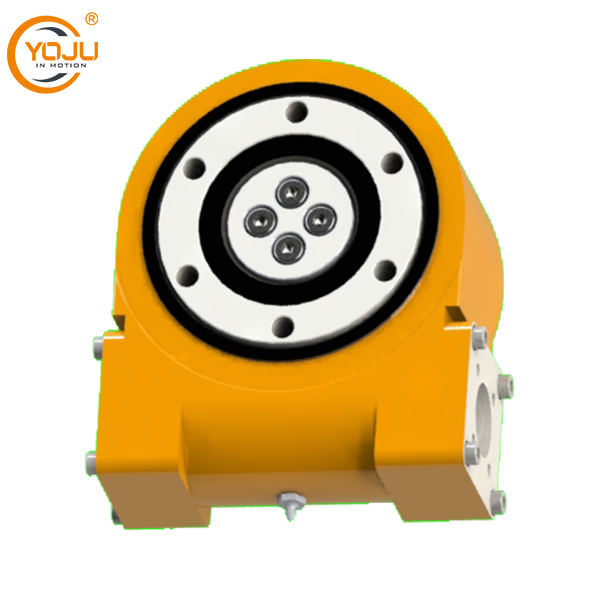Optimizing Lifting Performance with Truck Crane Slewing Drive
Introduction
In modern construction and transportation industries, the truck crane slewing drive plays a vital role in ensuring smooth, efficient, and precise lifting operations. As truck cranes are required to handle heavy loads while maintaining mobility and stability, the slewing drive system becomes a key component that enables controlled rotation, positioning accuracy, and overall structural balance. This article explores the working principles, key components, benefits, and technological innovations of truck crane slewing drives, highlighting how they enhance performance, safety, and productivity in demanding lifting environments. In this blog post, YOJU, a professional custom precision slew drive manufacturing factory, will share the components of truck crane slewing drive, its advantages, applications, etc.
Understanding the Function of Truck Crane Slewing Drive
A truck crane slewing drive is a gear-based rotational mechanism that allows the upper structure of the crane—including the boom, counterweight, and operator’s cabin—to rotate around its base. This motion provides a full range of movement, enabling operators to position loads with high precision.
The slewing drive typically integrates a slewing bearing, worm gear, housing, and motor. It transmits torque from the motor to the slewing bearing, allowing for smooth 360-degree rotation. Its compact structure and high torque output make it ideal for truck cranes that demand strong load-bearing capacity without compromising on installation space.
Key Components of Truck Crane Slewing Drive System
-
Slewing Bearing – Acts as the central element that supports axial and radial loads while enabling rotation. It ensures stability and reduces vibration during lifting operations.
-
Worm Gear and Worm Shaft – Converts rotational motion from the motor into torque, providing self-locking capability that prevents reverse motion and enhances safety.
-
Drive Motor – Usually a hydraulic or electric motor, it provides the required energy to rotate the upper structure with precise speed control.
-
Housing and Sealing System – Protects internal components from dust, debris, and moisture, ensuring long-term reliability and minimal maintenance.
Together, these components form a compact, durable, and efficient drive system essential for modern truck cranes.
Advantages of High Precision Slewing Drive for Truck Cranes
The slewing drive for truck cranes offers multiple performance benefits that directly influence the machine’s efficiency and operational stability:
-
Enhanced Load Control: The gear design provides smooth rotational motion and allows precise positioning of heavy loads.
-
High Safety and Reliability: The self-locking worm mechanism prevents the boom from rotating unintentionally, ensuring stability even when power is lost.
-
Compact Design: Integrating the bearing and gear into one unit minimizes space requirements, making it suitable for mobile cranes.
-
Reduced Maintenance: Sealed designs and durable materials extend service life, reducing downtime and maintenance costs.
-
Versatile Mounting Options: The modular design enables flexible installation, supporting both horizontal and vertical mounting configurations.
These advantages make slewing drives indispensable for ensuring operational excellence in various lifting and construction applications.

Innovations in Truck Crane Slewing Drive Technology
With the growing demand for smarter, more efficient lifting equipment, truck crane slewing drive technology has evolved significantly. Modern designs incorporate advanced materials, intelligent control systems, and energy-efficient motors.
-
Digital Load Monitoring: Integration with sensors allows real-time feedback on load torque and rotation angle, improving control accuracy.
-
Lightweight Alloy Construction: The use of high-strength, lightweight materials reduces the overall crane weight, improving mobility and fuel efficiency.
-
Hydraulic-Electric Hybrid Drives: Combining hydraulic power with electric precision enhances speed control and reduces energy consumption.
-
Automated Lubrication Systems: Built-in lubrication units extend the lifespan of gears and bearings while minimizing manual maintenance.
These innovations not only improve operational safety but also align with sustainability trends in construction machinery design.
Applications of Slewing Drives in Mobile and Truck Cranes
Truck-mounted cranes rely heavily on slewing drives for lifting, rotating, and positioning loads in confined or dynamic environments. Applications include:
-
Construction Sites: For positioning concrete panels, steel beams, and other heavy materials with precision.
-
Transportation and Logistics: Loading and unloading cargo in ports, warehouses, and industrial facilities.
-
Utility and Maintenance Services: Used in mobile cranes for power line installation, tower maintenance, and equipment servicing.
-
Emergency and Rescue Operations: Enables rapid setup and controlled movement in disaster response scenarios.
Each application benefits from the reliability, compactness, and torque performance of the slewing drive mechanism.
Choosing the Right Slewing Drive for Truck Cranes
Selecting an appropriate truck crane slewing drive unit depends on several key factors:
-
Load Capacity and Torque Requirements: The drive must handle both dynamic and static loads during lifting.
-
Rotation Speed and Precision: High-precision drives are ideal for applications requiring smooth and accurate motion.
-
Environmental Conditions: Corrosion-resistant and sealed models are suitable for outdoor or harsh environments.
-
Motor Type and Power Source: Compatibility with the crane’s hydraulic or electric system ensures optimal performance.
-
Maintenance and Durability: Preference should be given to designs with minimal maintenance and long service intervals.
By carefully matching the slewing drive specifications with the crane’s operational parameters, manufacturers can achieve optimal balance between performance and cost.
Future Trends in Truck Crane Slewing Drive Development
As the construction and logistics industries continue to evolve, future truck crane slewing drives will likely integrate smart monitoring, predictive maintenance, and lightweight composite materials. The focus will shift toward eco-friendly manufacturing and IoT-enabled components that provide real-time diagnostics and fault alerts.
In addition, advances in robotics and automation will drive the development of self-adjusting slewing systems capable of learning from operational data to optimize performance dynamically.
Conclusion
The truck crane slewing drive represents the cornerstone of modern lifting technology, combining precision engineering with mechanical strength to enable safe and efficient rotation under heavy loads. Its integration of advanced materials, intelligent control, and robust design ensures that truck cranes can perform complex lifting operations with reliability and accuracy. As innovation continues to shape the field, slewing drive systems will remain central to the evolution of next-generation mobile lifting equipment.
www.enyoju.com
YOJU
Post Comment